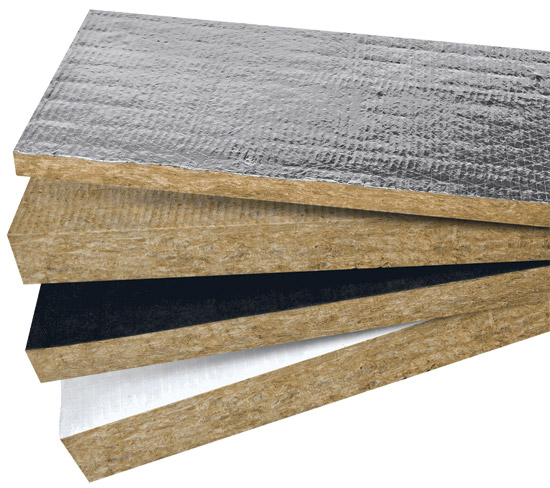Stone Wool Roof Insulation - A Climate Driven Choice
 |
Comparative temperature development in a standard ASTM E119 fire test showing melting or burning points of foam insulation compared to stone wool insulation. Chart courtesy of ROXUL, Inc. |
Fire Resistance
Fire resistance describes how well a building component can—for a stated period of time—hold back fire and prevent it from penetrating from one room to another. The basic criteria used to characterize the fire resistance of a product are flame spread, smoke development, and non-combustibility. Because of its stone and slag makeup, stone wool excels in all three of these criteria. It will not develop toxic smoke or promote flame spread, even when directly exposed to fire, as some other insulation materials do. When tested in accordance with ASTM E 84 stone wool typically shows a flame spread of 0 and a smoke development of 0. By comparison, spray polyurethane foam [SPUF] tested to ASTM E 84, typically achieves a flame spread of 25 and smoke developed in the 350 to 500 range.
Beyond these basic fire resistance properties, stone wool insulation has an impressive ability to withstand temperatures up to its melting point of approximately 2,150°F (1,177°C). Photo #7 As such, it can act as a fire barrier, when used in conjunction with appropriate fire sealant materials, thus helping to prevent the spread of fire and potentially providing valuable extra minutes to save people and property. This is in contrast to other insulation materials and many other building materials.
Since stone wool insulation does not contribute to fire propagation, it may provide additional escape time to occupants. It may also provide fire services personnel with additional time to both clear occupants, and control the spread of fire while delaying the collapse of various structural members of the building. As a result, architects should take into account the added value of passive fire resistance which can be achieved by using stone wool insulation in buildings.
Insulation for Acoustical Control
Acoustical control has become a growing concern in buildings of all types, particularly in school, healthcare, and office settings where people are trying not to be distracted by unwanted noise. There are a number of references and standards available to help determine acceptable background noise levels but it is incumbent on the building designers to focus on achieving them by restricting unwanted sound from entering the spaces. This means creating wall, floor, and roof components or assemblies that effectively control the amount of airborne sound transmitted through them. The measurement for this effectiveness is determined by a Sound Transmission Class (STC) rating. A higher STC rating means that more airborne sound is blocked by the component or assembly. Lower STC ratings mean that more sound passes through the components or assemblies, adding to the background noise level in the space, degrading the ability to hear and understand speech, and leading to occupant discomfort.
 |
Different thicknesses of stone wool insulation can be used in buildings to improve acoustic performance. Image courtesy of ROXUL, Inc. |
It should be noted that, contrary to the popular notion that sound passes through a structure, such is not always the case. Sound generated on one side of a wall will energize the wall structure and set it in motion, much like a diaphragm. The wall itself becomes the transmitter of the sound energy which can be heard on the opposite side of the wall by the listener. Hence, the ASTM test methods used to determine STC ratings have focused on this direct transmission process, although this testing has changed over the years meaning that STC results posted before 1999 may not produce the same results today.
Currently, the STC number is derived from sound attenuation values tested at 16 standard frequencies from 125 Hz to 4,000 Hz. The measurement is accurate for speech sounds but less so for amplified music, mechanical equipment noise, transportation noise, or any sound with substantial low-frequency energy below 125 Hz. Therefore, as a supplement to STC ratings, the Outdoor-Indoor Transmission Class (OITC) is a standard that is weighted more to lower frequencies (down to 80 Hz) used for indicating the rate of transmission of sound between outdoor and indoor spaces in a structure (i.e. aircraft / rail / truck traffic).
At least one significant research study by G. W. Evans & Maxwell considered students at a school in the regular flight path of an airport. After taking into account variables such as socioeconomic status, students in that school performed as much as 20 percent lower on a reading test than students in another nearby school, indicating a strong correlation between sound levels and learning.









